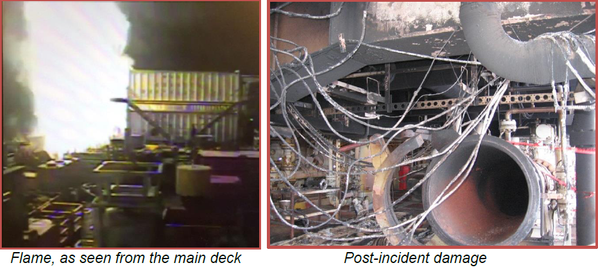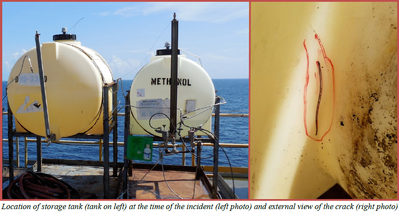
A November 2017 explosion on an offshore production platform, a July 2018 platform diesel generator fire, and an August 2018 leak of 70 gallons of emulsion breaker into the Gulf of Mexico were the focus of a spate of safety bulletins and alerts from Bureau of Safety and Environmental Enforcement (BSEE) this week.
"Our goal with Safety Bulletins is to share the lessons learned from an incident or a near miss," said Harold Griffin, BSEE petroleum engineer, Gulf of Mexico Region Pipeline Section. "It also contains recommendations that should help prevent the recurrence of such an incident on the Outer Continental Shelf."
The BSEE investigation into the November 2017 explosion and fire on a Gulf of Mexico production platform concluded improper procedures caused the accident and subsequent evacuation.
BSEE’s resulting Safety Bulletin No. 014, issued on December 6, 2018, recommended the importance of adhering to established original equipment manufacturer (OEM) and operator procedures, even during routine tasks.
The task that led to the incident had the crew performing the 30-inch sales gas pig loading procedure. After loading the pig and closing the pig launcher door, the crew began to pressurize the pig launcher. An explosive gas release occurred at around 300 psi, causing the pig launcher door to separate from the pig launcher.
It is believed metal-to-metal contact or electrical arcing from the blast damage ignited the resulting fire, which burned for nearly 27 hours after activation of the emergency shutdown system while the remaining gas volume in the sales gas pipeline vacated through the pig launcher door opening.
The BSEE investigation concluded the crew failed to secure the pig launcher door according to OEM procedures, so the pig launcher door did not properly seal. Furthermore, according to the safety bulletin, the crew neglected to lock out and tag out (LOTO) some of the valves as outlined in their job procedure.
In addition to incorporating OEM procedures into operator-approved job procedures, BSEE recommends operators consider implementing visual or other verification methods for proper pig launcher door seal as a procedural step, as well as emphasizing the importance of adhering to LOTO procedures.
Corrosion Under Insulation
The July 2018 platform diesel generator fire occurred inside a generator enclosure, leading BSEE to release Safety Bulletin No. 013. While the cause of the fire was inconclusive, the investigation team identified discoloration of the exhaust pipe insulation blankets, soot build-up around the exhaust flanges, and holes and/or complete separation of the exhaust piping due to excessive corrosion.
There was an identical generator on the same facility, and BSEE inspected that one, which revealed the same corrosion-related issues. Corrosion beneath the insulation blankets was severe and affected the exhaust piping at the same points as the unit that experienced the fire, according to BSEE.
Although this safety alert from BSEE focuses on insulation effects on corrosion associated with generator exhaust systems, the bureau corrosion issues also exist on process piping, valves, and vessels that have been covered with insulation for extended periods. Surfaces covered by decals may face similar corrosion issues, the bureau added.
BSEE recommends operators survey engine exhaust components such as firewater pump drivers, cranes, compressors, and generators to identify exhaust leaks, and the expand their piping and vessel inspection programs to include routine inspections of all components covered with insulation or decals to identify corrosion issues that could result in process leaks. Such inspections may require removal of protective guards as well as the insulation.
 (Source: BSEE)
(Source: BSEE)
Emulsion Release
Equipment failure of a tank on an unmanned platform led to a release of 70 gallons of an emulsion breaker composed of 40% xylene into the Gulf of Mexico, an operator reported in August 2018. The chemical had been stored in a polyethylene tote.
Through the BSEE investigation, reported in Safety Alert No. 344, it was determined the release stemmed from a crack along the bottom of the tote and that the interior of the tote’s walls showed dimples and reduced wall thickness throughout the fluid contact area. Additionally, it was improperly labelled as containing “Corrosive” contents versus “Flammable” contents per the Safety Data Sheet. Further investigation revealed the secondary containment pan had filled with rain water and was incapable of retaining the tote’s contents. According to the chemical provider, the emulsion breaker is shipped in 304/316 stainless steel totes and should be contained in same or polyvinylidene fluoride or polyvinylidene difluoride totes.
BSEE concludes the chemical was stored in an improper container, and that the degradation or damage cause through improper storage is considered a contributing cause to the tote’s failure. Further concludions included that the tote had been exposed to sun and weather for more than five years, and the elements and UV exposure may have contributed to the tank’s failure. The improper labeling on the tote increased risks to personnel and the environment. Also, according to BSEE, there should have been a means for removing rainwater from the secondary containment, allowing room to contain any chemical spillage.
As a result of this incident, BSEE recommends operators ensure tote compatibility with the chemicals they are storing, and that all are properly labeled. Personnel should be properly trained and fully understand the implications of the chemicals used on their facilities. Further, BSEE recommends evaluating and inspecting all chemical storage containers and supporting structures to ensure they are fit for continued service.
 (Source: BSEE)
(Source: BSEE)



